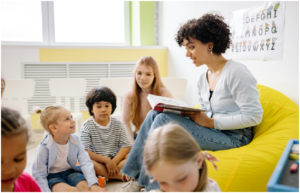On any general day at school, students tend to greet their students with a smile and a good morning to begin their days. Students also greet their peers every day whom they know for months or even a year. In these ways, teachers stay connected with children and form a strong bond with them.
Many people don’t understand the importance of social and emotional learning and how important it is to give a sense of belonging to students.
However, many research have suggested that when students have a supportive learning environment and where teachers put effort into building a relationship with them and creating a safe environment for them improves their engagement rate in the classroom.
If you also want to know how you can build a solid relationship with your students, then we have got you covered.
In this blog post, we will be sharing some of the effective strategies to foster strong relationships with students which improve the overall engagement rate and learning motivation of the students.
Greet Your Students
As a teacher, you must always need to make your students feel that you care for them and have affection for them. For children in the classroom or in the online classroom, simple daily hellos will make them feel valued and improve their mood to get engaged in the classroom for their learning journey.
Do Your Morning Meetings Right
Routines are one of the important aspects of every classroom which fosters connections with each other and help finding ways for students to experience them at home will help ease the transition to home-based learning. “If you hold a morning meeting, consider the aspects of your meeting and what can be accomplished electronically at home. If technology permits, record and distribute daily video announcements and read-aloud.
Do a Regular Check-Ins
Routine, daily check-ins, or asking students to choose an emoji that matches their mood. You can encourage students to give you a thumbs up, sideways, or down to summarize their day.
Along with checking in with kids, teachers can also encourage students to do regular check-ins with their peers as well. Each student should be assigned the duty of interacting with one classmate. Then after check-ins, they can write how their peers are doing today!
Learn, how you can connect with your students effectively, here:
Use SNAIL-MAIL PEN PALS, PHONE PALS
Every student tends to learn better in social contexts. However, many students find it difficult to transition to learning from home since they are cut off from their peers, despite the fact that many older students communicate with their peers and friends via social media and texting.
If technology isn’t available, you can consider creating pen pals or other paper-and-pen activities or setting up phone pals where students can call their peers on the phone several times a week to discuss particular topics and different prompts.
As a responsible teacher, you can also consider using platforms like Zoom to deliver whole-group education with ‘breakout rooms’ where students can reflect on what they’ve learned together. Then you can form a deep relationship with students by having one-on-one sessions and having them read aloud for a few minutes.
Creating Virtual Tables
You can consider creating a virtual table group for older students. for discussion. Let four to five students maximum to participate in each group which will give them the opportunity to discuss their assignments, ask each other questions, and stay connected.
Although many children will maintain contact with their close friends, it’s important to consider pairing children with peers who are not in their immediate social circle and then rotate the groups on a weekly basis.
Involve Parents
Parents are one of the vital members in every child’s life and you must also focus on building a positive relationship with them as well. You can set a discussion session with the children’s parents which will give them the opportunity to raise any concerns, ask any of their doubts or they can even give their feedback.
You can also consider sending emails to children’s parents to check up on children’s parents by asking -How are you doing? How their children are doing? etc. This will also make them feel valued and you can build a long-lasting relationship with them.
Help Children ToAnalyze& Process Their Emotions
Suggesting students to be involved with writing assignments about their feelings and thoughts can significantly help them to analyze and process their emotions. Children can face difficult emotions and thoughts due to disrupted habits and schedules, social isolation, and challenges in their personal lives.
You can first suggest they write on paper about how they feel then you can have a one-on-one conversation to understand their feelings and thoughts, which will make them feel valued and heard.
Foster Strong Relationship During School Closure
Helping students to develop their socio-emotional skills is equally important like performing well in academics. You can follow the above-mentioned tips to develop strong bonds and relationships with your students which will eventually improve their engagement towards their learning journey.
If you want to learn more effective teaching strategies to help students thrive in their academic and personal lives. Then, consider pursuing courses like online teacher training course in Mumbai, where you will get to learn from top expert trainers from the education industry.



